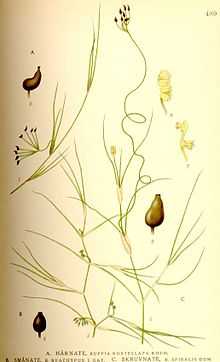Ruppia
| Ruppia | |
|---|---|
 | |
| Ruppia rostellata, R. brachypus, + R. spiralis[1] | |
| Scientific classification | |
| Kingdom: | Plantae |
| (unranked): | Angiosperms |
| (unranked): | Monocots |
| Order: | Alismatales |
| Family: | Ruppiaceae Horan.[2] |
| Genus: | Ruppia L. |
| Synonyms[3] | |
| |
Ruppia, also known as the ditch grasses or widgeon grass, is the only genus in the family Ruppiaceae. These are aquatic plants widespread over much of the world.[3] The genus name was given in honour of Heinrich Bernhard Rupp, a German botanist (1688-1719).[4] They are widespread outside of frigid zones and the tropics.
Description
The leaf is simple and non-rhizomatous. They can be annual (commonly) or perennial (rarely); Stem growth is conspicuously sympodial but sometimes this is not. This species are adapted to be in brackish water (and salt marshes). The leaves are small, or medium-sized. Their disposition can be alternate, opposite or whorled (usually alternate except when subtending an inflorescence). Even, lamina keep entire and it is setaceous, or linear. Leaf just shows one vein without cross-venules. The stomata is not present. The mesophyll leaks calcium oxalate crystals. The minor leaf veins don't present phloem transfer cells. and leaks vessels.
These plants have stem without secondary thickening and xylem without vessels. The sieve-tube plastids are P-type. The root xylem doesn't present vessels.
These plants are hermaphrodite, with anemophilous or hydrophilous pollination. The flowers are ebracteate, small and regular. Commonly, the flowers are aggregated in ‘inflorescences’, but sometimes they are solitary. Often they grow in racemes, spikes or umbels. The scapiflorous inflorescences are terminal, in short spikes or subumbelliform racemes, sometimes one- or few-flowered. They don't have hypogynous disk. These flowers don't have perianth absent, except when small staminal appendages are regarded as perianth segments. The androecial members are all equal. The androecium just present 2 fertile stamens with sessile anthers dehiscing via longitudinal slits. The pollen is polysiphonous and its grains are 3-celled nonaperturate. The gynoecium (2–)4(–16) is superior, carpelled and eu-apocarpous. The carpel is non-stylate, apically stigmatic with the stigma peltate or umbonate. These flowers only present 1 ovule pendulous, non-arillate, campylotropous, bitegmic and crassinucellate. The placentation is apical and embryo-sac development is of polygonum-type. Before fertilization they fuse a polar nuclei. The fruit is drupaceous, fleshy forming an aggregate. The fruiting carpel is indehiscent, commonly on a long, spirally twisted peduncle, (with each drupelet becoming very long-stalked). The fruit contents 1 non-endospermic seed with starch. The embryo can be straight or slightly curved. Membranous testa don't have phytomelan
Taxonomy
The Cronquist system, of 1981, placed the family in order Najadales of subclass Alismatidae in class Liliopsida [=monocotyledons] in division Magnoliophyta [=angiosperms].
The APG II system, of 2003 (unchanged from the APG system, of 1998), does recognize such a family and places it in the order Alismatales, in the clade monocots.
According to the AP-Website the family is doubtfully distinct from the family Cymodoceaceae: the plants in the three families Cymodoceaceae, Posidoniaceae and Ruppiaceae form a monophyletic group.
A genus-level taxonomy was briefly revised by Zhao and Wu,[5] including the following species in the world:
- species[3]
- Ruppia cirrhosa - temperate regions: Europe, Asia, north + south (but not tropical) Africa, North America, West Indies, Argentina
- Ruppia didyma - Mexico, West Indies
- Ruppia drepanensis - western + central Mediterranean
- Ruppia filifolia - southern South America, Falkland Islands
- Ruppia maritima - seashores and lakeshores around the world
- Ruppia megacarpa - Australia, New Zealand
- Ruppia polycarpa - Australia, New Zealand (incl Chatham Islands)
- Ruppia tuberosa - Australia
Phylogeny and evolution
The first molecular phylogeny of the monogeneric family discerned three distinct species, R. tuberosa, R. megacarpa, and R. polycarpa, and one species complex comprising six lineages.[6] The species complex, named R. maritima complex,[6] was later updated as a group of eight lineages.[7] These studies revealed that multiple hybridization and polyploidy events as well as chloroplast capture have occurred in the evolution of the genus.
Phytochemistry
These plants present an anatomy non-C4 type. Seven labdanes have been identified from this genus:
- ent-14,15-Dinor-8(17)-labden-13-one
- Methyl ester of (ent-12S)-15,16-Epoxy-12-hydroxy-12-oxo-8(17),13(16),14-labdatrien-19-oic acid.
- (-)-15,16-epoxy-8(17),13(16),14-labdatrien-19-ol.
- Methyl ester of (-)-15,16-epoxy-8(17),13(16),14-labdatrien-19-oic acid.
- (-)-15,16-Epoxy-8(17),13(16),14-labdatrien-19-al.
- (-)-15,16-Epoxy-8(17),13(16),14-labdatrien-19-yl acetate
- (ent-13E)-8(17),13-Labdadien-15-ol
Three steroids have been also isolated:
- (3β,5α,6β,7α,22E,24R)-Ergosta-8(14),22-diene-3,6,7-triol.
- (3β,5α,6β,7α,22E,24R)-Ergosta-8,22-diene-3,6,7-triol
- (24R)-Ergost-4-ene-3,6-dione.
References
- ↑ painting by the Swedish botanist C. A. M. Lindman (1856–1928), taken from his book(s) Bilder ur Nordens Flora (first edition published 1901–1905, supplemented edition 1917–1926?)
- ↑ Angiosperm Phylogeny Group (2009). "An update of the Angiosperm Phylogeny Group classification for the orders and families of flowering plants: APG III" (PDF). Botanical Journal of the Linnean Society 161 (2): 105–121. doi:10.1111/j.1095-8339.2009.00996.x. Retrieved 2013-07-06.
- ↑ 3.0 3.1 3.2 Kew World Checklist of Selected Plant Families
- ↑ Genaust, Helmut (1976). Etymologisches Wörterbuch der botanischen Pflanzennamen ISBN 3-7643-0755-2
- ↑ Zhao L.-C., Wu Z.-Y. (2008) A review on the taxonomy and evolution of Ruppia. Journal of Systematics and Evolution 46: 467–478.
- ↑ 6.0 6.1 Ito, Y., T. Ohi-Toma, J. Murata & Nr. Tanaka (2010) Hybridization and polyploidy of an aquatic plant, Ruppia (Ruppiaceae), inferred from plastid and nuclear DNA phylogenies American Journal of Botany 97: 1156-1167
- ↑ Ito, Y., T. Ohi-Toma, J. Murata & Nr. Tanaka (2013) Comprehensive phylogenetic analyses of the Ruppia maritima complex focusing on taxa from the Mediterranean Journal of Plant Research 126: 753-762
External links
| Wikimedia Commons has media related to Ruppiaceae. |